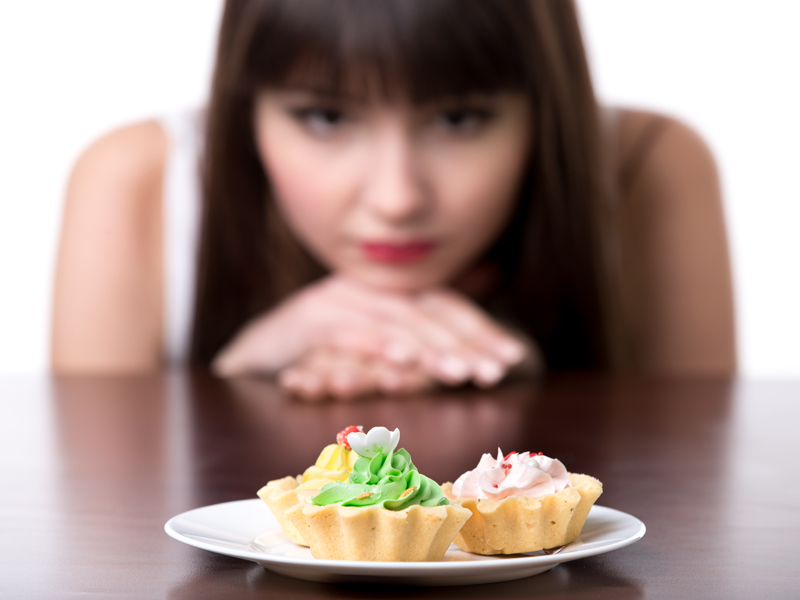Get Easy Health Digest™ in your inbox and don’t miss a thing when you subscribe today. Plus, get the free bonus report, Mother Nature’s Tips, Tricks and Remedies for Cholesterol, Blood Pressure & Blood Sugar as my way of saying welcome to the community!
4 steps to curb cravings

Surveys estimate that almost 100 percent of women and nearly 70 percent of men had food cravings during the past year.
That means most of us experience food cravings on a regular basis. But what causes them?
The old model assumed people ate because they were undisciplined. That’s what we were told for nearly 40 years — and to go out and exercise the excess away.
The current theories are more complex and include three main causes:
- Gut: Energy insufficiency — we eat when we are hungry. The presence of layers of infection demand imbalanced food choices (i.e. yeast breeds on sugar). This is brought on by leaky gut syndrome and habitual poor food choices. Leaky gut syndrome prevents us from absorbing sufficient nutrients such as macronutrients from quality proteins, fats and carbohydrates; micronutrients we get from minerals, spices and herbs; and phytonutrients found in real fruits and vegetables).
- Brain: Satiety centers in our brains respond to hormones, like grehlin and leptin, which tell us when to eat and when to stop. These are triggered by external cues (billboards, local fast food restaurants; ice cream, candy, donuts, and coffee shops abound). Some foods cause neurotransmitter imbalances in the brain (like sugar does with dopamine and serotonin) that are best avoided.
- Emotions: Our thoughts and emotions lead us to food choices, and usually to specific comfort foods when we are stressed out. Our social scene whether out with friends or family or in the break room for lunch — also affect the quality and quantity of our food choices.
When we do get a “craving” it is usually for a “comfort” food that we learned early on in our lives would cause immediate soothing.
Most of us crave foods that are highest in fat, closely followed by carbohydrates, and usually include almost no protein. The lack of protein with a snack or meal may cause hunger or cravings to return sooner.
What this tells us is, fat can immediately satisfy and “satiate” — or give a feeling of fullness. It also can trigger the hormones in the brain that give pleasure and calm us.
The problem, as we know, is that these foods, usually consumed in excess, set us up for leaky gut syndrome, cardiovascular problems and weight gain. These consequences are highly underestimated in society.
The good news is: there is a way to cut the cravings…
My 4 step strategy to curb the cravings
- Plan ahead. This includes shopping once a week for the organic produce that allows for a diverse meal options:
- Consider four or more leafy green choices — like kale, swiss chard, spinach, arugula — enough for salads for two meals (first course of lunch and dinner) per day for one week.
- Colors — get at least one per color for second layer for each salad: Purple cabbage, onions (red, yellow), peppers (red, yellow and orange), carrots, tomatoes.
- Cook grains and/or legumes (beans or lentils) twice per week (i.e. Sunday and Wednesday) — enough for three days. One favorite: Quinoa because it has half the carbs and twice the protein as another favorite — brown rice.
- Consider also cooking fish, chicken or meat just twice a week to save time in food prep on other days.
- Always have prepared food with you (i.e. fruit, nuts, seeds, cheese, veggies cut up). This means in BPA-free containers in your purse, bag or car.
- Fill up on the good stuff first.
- Drink water before you eat. Yes, plan to have water to drink wherever you go. Drink throughout the day, and when first hungry to test the authenticity of your hunger. Drink only about 4 ounces with your meal, because you drank routinely through the day and up to 8 ounces before (20 minutes) the meal. Not only is water a great appetite suppressant, drinking plenty will aid digestion.
- Eat nutrient-dense, healthy food that you have already prepared before considering “junk food” cravings. Salads don’t seem “sexy,” especially when you are really hungry (now!), but once you start in — you will realize how fulfilling they are — and the cravings usually disappear. Especially if you eat a superfood detox salad.
- Allow time to eat and feel full — eat in gratitude. Be present — no other activities, except relaxing, positive, supportive social interaction while eating. When three-fourths full — stop, wait 20 minutes, allowing digestion. See how you feel. If you are still hungry — move on to your second course — grains, legumes, soup, meat/chicken, fish, and healthy oils.
- Get new “go to” foods that satisfy cravings: (See substitution foods below)
- Desserts — find a delicious smoothie recipe to help quench a sweet craving — like this red velvet cake smoothie. Or better yet, a dessert that helps you eat better and lose weight: It’s referred to as the three pleasures and consists of nuts, fruit and dark chocolate. Research has shown that cutting out sweets altogether can backfire, so soothe your sweet tooth the right way.
- Evening — consider tea — up to three 8-ounce cups of herbal tea. This satisfies the “fullness” craving, physically and emotionally. This improves quality sleep, sooner. It also promotes timely cleansing and detoxification (a daily routine for your liver and other organs of detoxification) through the night.
- Finally, if you have to eat that “junk food,” you will “crave” less if you are full of nutrient-dense foods and plenty of water or healthy herbal tea. Your new “go to” foods for “cravings” may all be healthy choices.
- Get real with your emotions.
Balancing your thoughts and emotions in response to life (handling stress well) is key to eliminating cravings and addictions.
- Find out through counseling with a Life Coach or licensed professional what is “eating you.”
- Journal your responses to life. Acknowledge what creates stress in your life. Identify your fears for each event.
- Resolve to find solutions to reacting positively to situations that are stressful to you. Behaviors will only permanently change if we change the way we think and feel about events.
- Add physical exercise to your daily routine. Practice meditation, yoga, breathing exercises, and pick up a hobby, pet or service project.
Food craving substitutions
Cravings are like mixed messages. Get your body and your brain on the right track by getting to the root of your cravings and satisfying them with the right nutrients.
Here is a list of foods that your body and brain may prefer to find nutrient sufficiency and satiety. Consider eating these substitutions to prevent the following cravings:
If you crave cheese, it could be that your body isn’t getting enough of the essential fatty acids it needs. Give it a healthy dose of omega-3s found in flax oil, ground flax seeds, chia seeds or walnuts.
We all enjoy pasta, white bread and pastries, but too much is a bad thing. Cravings for these foods may be brought on because your body wants chromium. Better food choices to get this nutrient include: broccoli, barley, oats, green beans, tomatoes, romaine lettuce, black pepper, onions, grapes, apples, cinnamon and sweet potato.
If you especially crave toast, you may need more nitrogen. Foods containing proteins can curb this craving, along with green leafy veggies, nuts, seeds, legumes and grains.
Chocolate cravings could indicate you lack magnesium. Try raw cacao nibs, beans or powder; whole grains, beans, nuts, seeds, greens and fruit.
Candy cravings may indicate low blood sugar. Fix it with fruit and high fiber foods (beans and legumes), complex carbs (grains) or chromium (cinnamon).
Coffee or black tea cravings could indicate a shortage of sulphur, iron, salt and phosphorous. As I mentioned earlier, a switch to herbal teas is a much healthier choice. But foods that may help this craving include: Cruciferous vegetables, figs, dried fruit, sea salt, apple cider vinegar, kombucha, pumpkins seeds, whole grains and vitamin C.
You’re probably seeing a trend here… whole food basics — like leafy greens, grains, nuts, seeds and fruits — give your body what it needs. These are real whole foods that satisfy your belly as well as your body. Ultra-processed foods, which make up most of the Standard American diet, don’t — and that’s what leads to the cravings. Fill up with the good stuff and watch your cravings disappear.
Sources:
-
Sørensen MR1, Holm L2. “I feel good and I am not overweight” – A qualitative study of considerations underlying lay people’s self-assessments of unhealthy diets. Appetite. 2016 Jul 25;107:135-143. doi: 10.1016/j.appet.2016.07.032. [Epub ahead of print]
-
Martin Grosshans, MD; Christian Vollmert, MD; Sabine Vollstädt-Klein, PhD; Heike Tost, MD, PhD; Saskia Leber, MD; Patrick Bach, BS; Mira Bühler, PhD; Christoph von der Goltz, MD; Jochen Mutschler, MD; Sabine Loeber, PhD; Derik Hermann, MD; Klaus Wiedemann, MD; Andreas Meyer-Lindenberg, MD, PhD; Falk Kiefer, MD. Association of Leptin With Food Cue–Induced Activation in Human Reward Pathways. May 2012, Vol 69, No. 5. Arch Gen Psychiatry. 2012;69(5):529-537. doi:10.1001/archgenpsychiatry.2011.1586.
-
Hill AJ. The psychology of food craving. Proc Nutr Soc. 2007 May;66(2):277-85.
-
Lowe MR1, Levine AS. Eating motives and the controversy over dieting: eating less than needed versus less than wanted. Obes Res. 2005 May;13(5):797-806.
-
http://www.whfoods.com/genpage.php?tname=nutrient&dbid=51












